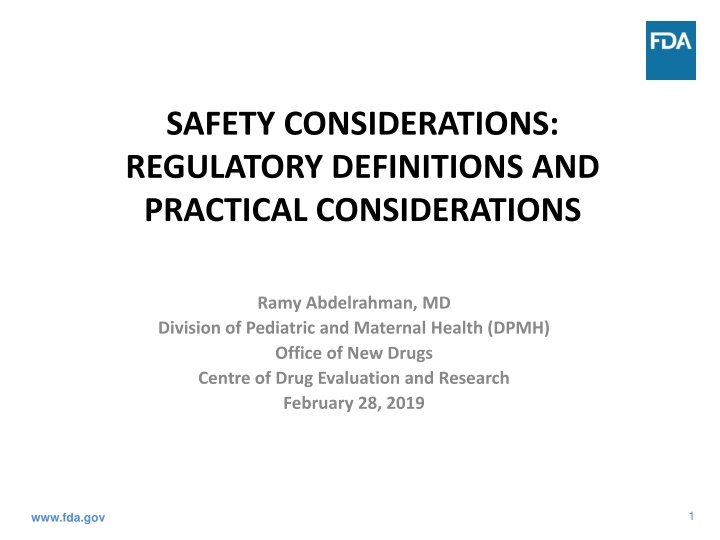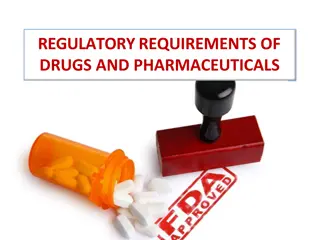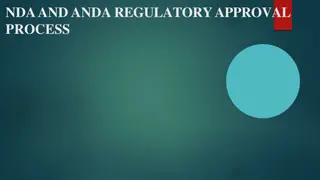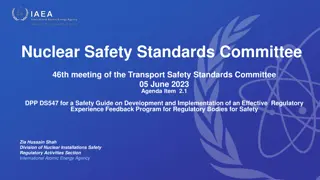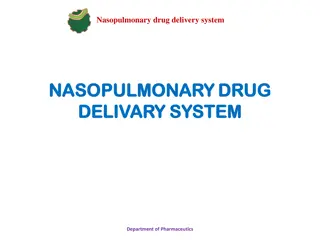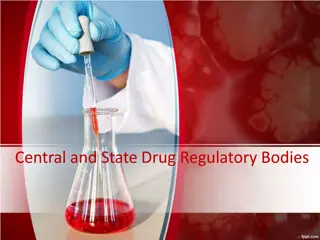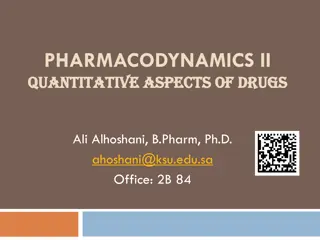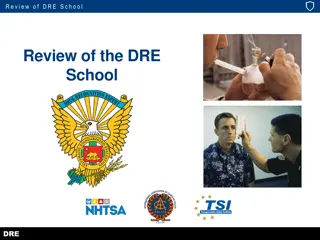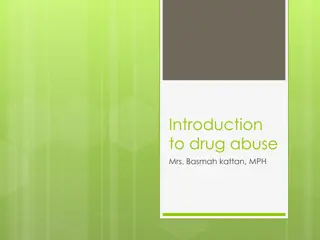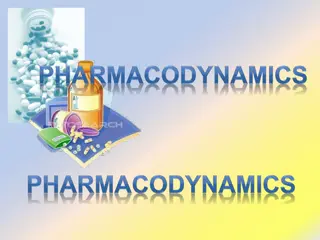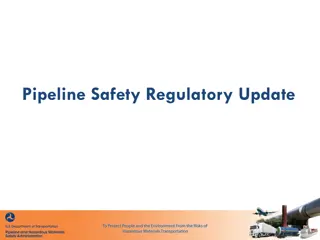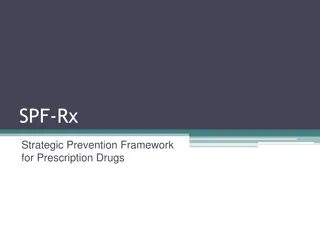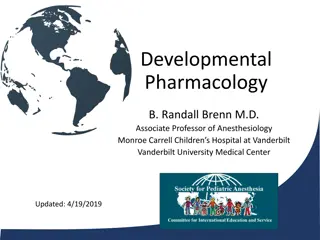Safety Considerations and Regulatory Definitions in Drug Evaluation
This presentation by Ramy Abdelrahman, MD, delves into safety considerations, regulatory definitions, and practical responsibilities in drug evaluation. It covers adverse events, suspected adverse reactions, and reporting responsibilities for investigators and sponsors. The content emphasizes making causality judgments and distinguishing between individual occurrences and aggregate analysis in ensuring drug safety.
Download Presentation

Please find below an Image/Link to download the presentation.
The content on the website is provided AS IS for your information and personal use only. It may not be sold, licensed, or shared on other websites without obtaining consent from the author.If you encounter any issues during the download, it is possible that the publisher has removed the file from their server.
You are allowed to download the files provided on this website for personal or commercial use, subject to the condition that they are used lawfully. All files are the property of their respective owners.
The content on the website is provided AS IS for your information and personal use only. It may not be sold, licensed, or shared on other websites without obtaining consent from the author.
E N D
Presentation Transcript
SAFETY CONSIDERATIONS: REGULATORY DEFINITIONS AND PRACTICAL CONSIDERATIONS Ramy Abdelrahman, MD Division of Pediatric and Maternal Health (DPMH) Office of New Drugs Centre of Drug Evaluation and Research February 28, 2019 1 www.fda.gov
Disclaimer I ve no financial interests or relationships to disclose The views presented here are personal and do not necessarily reflect the views of the Agency 2
Outline Definitions Investigator and sponsor reporting responsibilities IND safety reporting time frame 3
Adverse Event Adverse event means any untoward medical occurrence associated with the use of a drug in humans, whether or not considered drug related 4 www.fda.gov
Suspected Adverse Reaction Suspected adverse reaction means any adverse event for which there is a reasonable possibility that the drug caused the adverse event For the purposes of IND safety reporting, reasonable possibility means there is evidence to suggest a causal relationship between the drug and the adverse event. Who is responsible for making the causality judgment? FDA: the sponsor ICH E2A guidance: either the investigator or the sponsor 5
Individual Occurrences Certain serious adverse events are informative as single cases because they are uncommon and are known to be strongly associated with drug exposure (e.g., angioedema, blood dyscrasias, rhabdomyolysis, hepatic injury, anaphylaxis, and Stevens-Johnson Syndrome) 6
One or More Occurrences One or more occurrences of an event that is not commonly associated with drug exposure, but is otherwise uncommon in the population exposed to the drug If the event occurs in association with other factors strongly suggesting causation (e.g., strong temporal association, event recurs on rechallenge), a single case may be sufficiently persuasive to report in an IND safety report Examples: tendon rupture or heart valve lesions in young adults, or intussusception in healthy infants 7
Aggregate Analysis of Specific Events An aggregate analysis of specific events observed in a clinical trial that indicates those events occur more frequently in the drug treatment group than in a concurrent or historical control group Examples: Non-acute death observed in a trial in cancer patients Acute myocardial infarction observed in a long-duration trial in an elderly population with cancer 8
Adverse Reaction An adverse reaction means any adverse event caused by a drug 9
Unexpected Adverse Events An adverse event or suspected adverse reaction is considered unexpected if it is: Not listed in the investigator brochure for the particular drug under investigation (or elsewhere in the general investigational plan if an investigator brochure is not required or available) Not listed at the specificity or severity that has been observed, examples: Hepatic necrosis would be unexpected (by virtue of greater severity) if the investigator brochure referred only to elevated hepatic enzymes or hepatitis Cerebral thromboembolism and cerebral vasculitis would be unexpected (by virtue of greater specificity) if the investigator brochure listed only cerebral vascular accidents 10
Serious Adverse Events An adverse event or suspected adverse reaction is considered serious if, in the view of either the investigator or sponsor, it results in any of the following outcomes: Death Life-threatening adverse event Inpatient hospitalization or prolongation of existing hospitalization A persistent or significant incapacity or substantial disruption of the ability to conduct normal life functions, or a congenital anomaly/birth defect Important medical events may be considered serious when, based upon appropriate medical judgment, they may jeopardize the patient or subject and may require medical or surgical intervention to prevent one of the outcomes listed in this definition, Examples: Allergic bronchospasm requiring intensive treatment in an emergency room or at home Blood dyscrasias or convulsions that do not result in inpatient hospitalization 11
Life-Threatening Adverse Events An adverse event or suspected adverse reaction is considered life-threatening if, in the view of either the investigator or sponsor, its occurrence places the patient or subject at immediate risk of death. It does not include an adverse event or suspected adverse reaction that, had it occurred in a more severe form, might have caused death. 12
IND safety reporting The sponsor must submit an IND safety report when any of the following criteria are met: 1. Serious and Unexpected Suspected Adverse Reaction 2. Increased Occurrence of Serious Suspected Adverse Reactions 3. Findings From Other Sources 13
Findings From Other Sources The sponsor must report any findings that suggest a significant risk in humans exposed to the drug from: Epidemiological studies, pooled analyses of multiple studies or clinical studies Animal or in vitro testing, whether or not conducted under an IND or by the sponsor 14
Investigator and Sponsor Reporting Responsibilities Term Investigator Responsibility Sponsor Responsibility Final Determination Responsibility An event is considered serious or life-threatening, based on either the investigator s or sponsor s opinion. Yes (Investigator must report all serious adverse events to the sponsor immediately) Serious Yes (or life-threatening) The sponsor is responsible for determining whether event meets the definition of unexpected, based on whether the event is listed in the investigator brochure; or if an investigator brochure is not required or available, is not consistent with the risk information described elsewhere in the general investigational plan or elsewhere in the current application. No Unexpected Yes (No requirement to assess expectedness ) The sponsor is responsible for determining whether there is a reasonable possibility that the drug caused the adverse event, taking into consideration the investigator s assessment Yes Suspected Adverse Reaction (causality assessment standard - reasonable possibility ) Yes (Sponsor s assessment determines reportability, regardless of investigator s assessment) (Investigator must provide sponsor with an assessment of causality) 15
IND Safety Reporting Time Frame Initial reporting No later than 15 calendar days for unexpected serious suspected adverse reactions and observations from animal studies suggesting significant risk to human subjects No later than 7 calendar days for unexpected fatal or life-threatening suspected adverse reactions Follow-up reporting No later than 15 calendar days for follow-up information to a previously submitted IND safety report 16
References 21 CFR part 312 and part 320 FDA Guidance for Industry and Investigators: Safety Reporting Requirements for INDs and BA/BE Studies FDA Draft Guidance for industry: Safety Assessment for IND Safety Reporting 17
